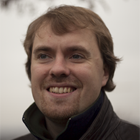Autonomous Robotic Manipulation
Modeling Top-Down Saliency for Visual Object Search
Interactive Perception
State Estimation and Sensor Fusion for the Control of Legged Robots
Probabilistic Object and Manipulator Tracking
Global Object Shape Reconstruction by Fusing Visual and Tactile Data
Robot Arm Pose Estimation as a Learning Problem
Learning to Grasp from Big Data
Gaussian Filtering as Variational Inference
Template-Based Learning of Model Free Grasping
Associative Skill Memories
Real-Time Perception meets Reactive Motion Generation
Autonomous Robotic Manipulation
Learning Coupling Terms of Movement Primitives
State Estimation and Sensor Fusion for the Control of Legged Robots
Inverse Optimal Control
Motion Optimization
Optimal Control for Legged Robots
Movement Representation for Reactive Behavior
Associative Skill Memories
Real-Time Perception meets Reactive Motion Generation
Layered Optical Flow

Layered models allow scene segmentation and motion estimation to be formulated together and to inform one another. They separate the problem of enforcing spatial smoothness of motion within objects from the problem of estimating motion discontinuities at surface boundaries. Furthermore, layers define a depth ordering, allowing us to reason about occlusions.
In [], we present an optical flow algorithm that segments the scene into layers, estimates the number of layers, and reason about their relative depth ordering using a novel discrete approximation of the continuous objective in terms of a sequence of depth-ordered MRFs and extended graph-cut optimization methods. We extend layer flow estimation over time, enforcing temporal coherence on the layer segmentation and show that this improves accuracy at motion boundaries.
In [], we extend the layer segmentation algorithm using a densely connected Conditional Random Field. To segment the video, the CRF can use evidence from any location in the image, not just from the immediate surroundings of a pixel. Additionally, the CRF drastically reduces runtime of the segmentation step, while preserving the high fidelity at motion boundaries.
PCA-Layers [] combines a layered approach with a fast, approximate optical flow algorithm. Within each layer, the optical flow is smooth and can be expressed using low spatial frequencies. Sharp discontinuities at surface boundaries, on the other hand, are captured by the layered formulation, and therefore do not need to be modeled in the spatial structure of the flow itself, allowing highly efficient layered flow computation.
We also use layered models in the treatment of motion blur []. In a dynamic scene, objects can move and occlude each other. Together with the nonzero shutter speed of the camera, this creates motion blur, which can be complex close to object boundaries; pixel values arise as a combination of foreground and background. Using a layered model allows us to separate overlapping layers from each other, making it possible to simultaneously segment the scene compute optical flow in the presence of motion blur, and deblur each layer independently.
Members
Publications


